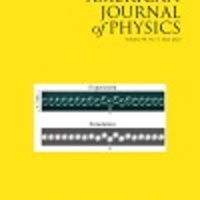Conservation Laws and Energy Transformations in a Class of Common Physics Problems
Item
Title
Conservation Laws and Energy Transformations in a Class of Common Physics Problems
List of Authors
Jonathan Bougie and Asim Gangopadhyaya
Abstract
We analyze a category of problems that is of interest in many physical situations, including those encountered in introductory physics classes: systems with two well-delineated parts that exchange energy, eventually reaching a shared equilibrium with a loss of mechanical or electrical energy. Such systems can be constrained by a constant of the system (e.g., mass, charge, momentum, or angular momentum) that uniquely determines the mechanical or electrical energy of the equilibrium state, regardless of the dissipation mechanism. A representative example would be a perfectly inelastic collision between two objects in one dimension, for which momentum conservation requires that some of the initial kinetic energy is dissipated by conversion to thermal or other forms as the two objects reach a common final velocity. We discuss how this feature manifests in a suite of four well-known and disparate problems that all share a common mathematical formalism. These examples, in which the energy dissipated during the process can be difficult to solve directly from dissipation rates, can be approached by students in a first-year physics class by considering conservation laws and can therefore be useful for teaching about energy transformations and conserved quantities. We then illustrate how to extend this method by applying it to a final example.
Date
2019
Publication Title
American Journal of Physics
Publisher
AAPT Physics Education
Identifier
DOI 10.1119/1.5125213
Bibliographic Citation
Jonathan Bougie and Asim Gangopadhyaya, “Conservation Laws and Energy Transformations in a Class of Common Physics Problems.” Am. J. Phys., 87(11), 868- 874 (2019).
